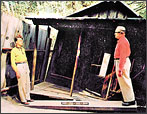
![]()
![]()
![]()
![]()
![]()
STRAIGHTENING OUT THE MYSTERY SPOT
The Santa Cruz Mystery Spot became more than just a roadside attraction a few years ago for two Berkeley psychology professors and a horde of graduate students. On a fun trip to the Santa Cruz boardwalk, the group, on a whim, checked out the rustic cabin advertised as an eerie site where "every law of gravitation has gone haywire."
What William Prinzmetal, Arthur Shimamura and their students found brought Prinzmetal back to the spot -- to do research -- 15 more times. What he found helps explain how the brain works -- not only at a tilted amusement park, but in serious situations as well.
"We've known since 1948 how the Mystery Spot sets up these illusions, because the same illusions were replicated in laboratory experiments," said Prinzmetal, who said all the tricks derive from the fact that the house is crooked. "But what we wanted to know is how the brain is working to come up with these strange interpretations of reality. Why is it that a tilted environment has such a big effect on us?"
He found the tricky optics are magnified two to three times when, in addition to visual cues such as a picture hanging askew, the perceiver's body also is at an angle. His finding sheds light on other poorly understood brain activity, such as airplane pilots' confusion over which direction is up.
Even though he now knows better, Prinzmetal said it's still a mystery to him how his brain continues to get fooled at the Mystery Spot.
![]()
![]()

![]()
[Table
of Contents]
[Berkeley
Magazine Home]
[UC
Berkeley Home Page]
Copyright 2000,
Regents of the University of California. All rights
reserved.
Comments? E-mail ucbwww@pa.urel.berkeley.edu.
